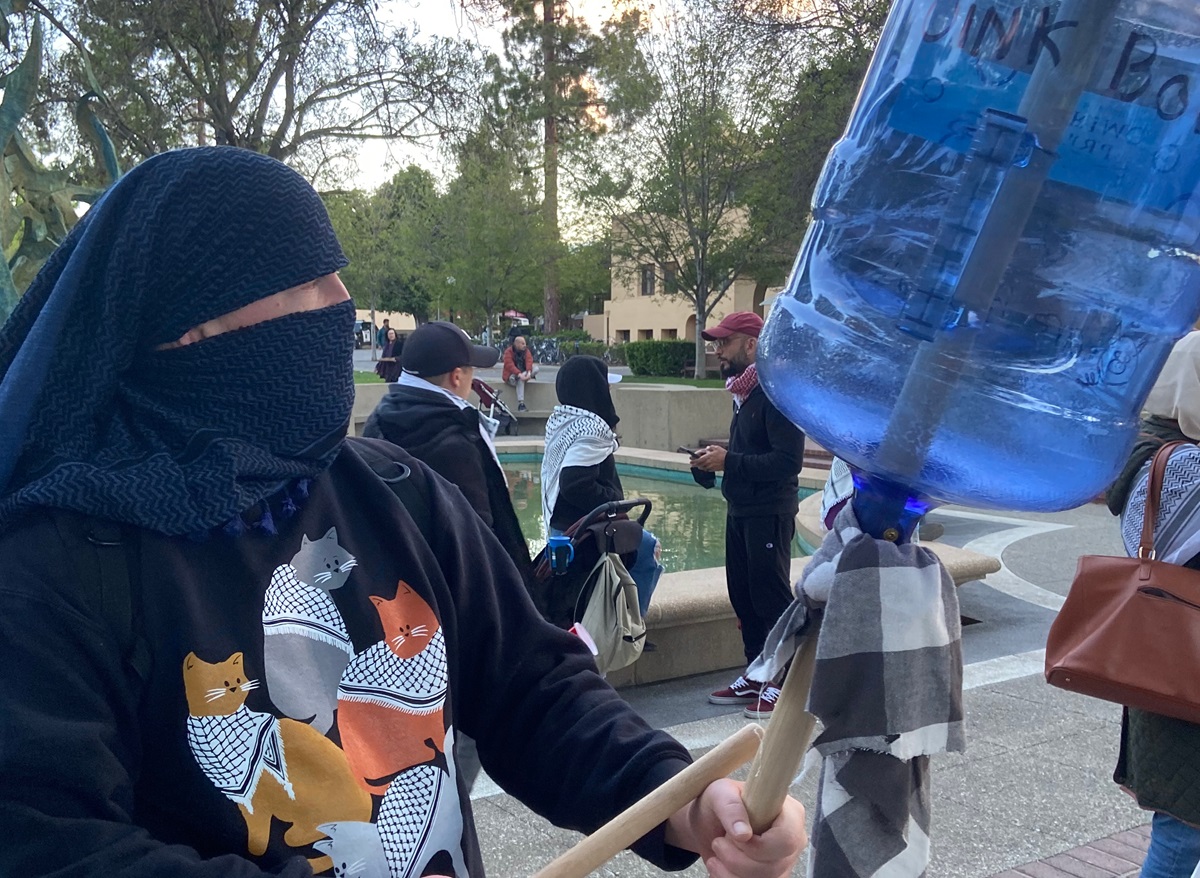Filed under: Anti-fascist, Trumpism, US, White Supremacy

Originally published on It’s Going Down
by Alexander Reid Ross
On a fast-pace, FOX News talk show discussing the recent beating of a Black Lives Matter protestor at a Trump rally, the presidential hopeful phoned in with an ambivalent tone. First contemplating the host’s term “roughed up,” the Don returned to the notion with more effrontery: “maybe he should’a been roughed up.”
Activists around the world signaled despair at the thought that the local violence against a Black Lives Matter protestor would translate to open season against protestors across the US. Perhaps unsurprisingly, it did, in Minneapolis, where white supremacists fired on a peaceful gathering of Black Lives Matter demonstrators, sending five to the hospital. According to reports, before they fired the shots, the culprits yelled, “Race war and Trump 2016!” Trump’s parallel non-response came in the form of a tweet—a meme with false information about “black-on-white crime” traceable to a neo-Nazi handle.
Despite the fact that even mainstream media sites and even conservative commentators have begun to note the proximities between Trump’s ideology and fascism, some more academic commentators still seem to be on the fence. One article states that describing Trump as a fascist “obscures the fact that Trump’s demagogic hate-mongering is deeply rooted in mainstream U.S. politics.” Some have even gone as far back as the 19th Century “Know Nothings” to identify Trump’s style.
We have seen Trump’s recent statements to the effect of issuing special IDs (perhaps badges?) to Muslims in the US and shutting down “certain” Mosques reflected in the opportunism of Republicans refusing Syrian refugees. Both seemed to land symbolically too close to the anniversary of the US’s rejection of the St. Louis carrying Jews fleeing from Nazi Germany, with the US Holocaust Museum pointedly condemning the treatment of Syrian refugees. We could further note that, according to his ex-wife, Trump used to read from a book of Hitler’s speeches, My New Order, kept in a cabinet near his bedside. There are also reports that when he visits, Trump’s cousin “clicks his heels and says, ‘Heil Hitler.”
While it is very useful to observe racist tendencies in the US and Europe before fascism (and even alongside it), I would argue for an alternative viewpoint. Returning to the 19th Century is provocative, but we would do well to identify the important influence fascism has had on the US (and vice-versa) not just as a detail, but as a significant milestone. Trump’s chatter belongs just as much in the fictional Hotel Wessex at the opening of of Sinclair Lewis’s 1935 warning of American fascism, It Can’t Happen Here, as it does in his own mega-hotels.
All in the Family
As is well-known, the Don’s father, Fred Trump, likely took part in the Klan’s militant street activity during the 1920s, which many would suggest represents a simple, US-American phenomenon. In fact, the Klan had heavy cross over with the American Legion, the leader of which announced in 1923, “Do not forget that the Fascisti are to Italy what the American Legion is to the United States” (don’t worry, we won’t). Just over a decade later, the Klan would join a united paramilitary organization called the Storm Troops with the corporate-funded Silver Shirts, the German American Bund (the Nazi Party in the US at the time), the Black Legion, and other racist neo-fascist groups. While the Klan is distinctly US-originated, by the end of the 1930s, they were intertwined with the US’s homegrown Nazis, and by the 1970s were inextricably united with David Duke’s brand of neo-fascism.
It wasn’t just the Klan, though. In 1976, correspondence between J Edgar Hoover and his “pen-pal” Nazis running Interpol during the late-1930s emerged, showing that Hoover’s autographed picture hung on the wall of Interpol’s offices in Nazi Berlin, and he remained on good terms with Nazi high officials until three days before Pearl Harbor. He became Interpol vice president in 1946, and refused to use his power to incarcerate Nazis war criminals on the run. Instead, through the State Department, the OSS, and FBI, the US brought Nazi scientists to the US, and helped coordinate the escape of numerous high ranking Nazis. To view neo-fascism as foreign to US groups like the Klan and neo-Confederate organizations is to ignore how it was absorbed in this country and to what utility.
The Klan has never been the sole or even principle point of intersection for US fascism; formal, official Americanism has always been the lynchpin. During the 1920s, the US’s great industrial and finance moguls, from Hearst, Ford, Du Pont, and GM to the house of JP Morgan, Jr., went fascist, and big business groups like the National Association of Manufacturers (NAM), a leading purveyor of Americanist propaganda, joined them. In 1923, after Mussolini’s March on Rome, the counsel of NAM delivered a speech to their convention called il Duce an “extreme leader, not only converted by the lightning stroke of intelligence and falling from his error like Saul of Tarsus from his horse, but leading through the streets of a reunited country a great body of citizens,” liberating Italy from “the blighting hand of radical socialism.”
Fascism and the Red Scare
Along with the NAM, the America First Committee, founded by publishing magnate Henry Regnery, warned that intervention in WWII would be traumatic to the US’s small and medium-sized manufacturers, insisting that the US maintain neutrality. One of NAM’s most well-regarded propagandists was a columnist named George Sokolsky, who famous anti-fascist journalist George Seldes aptly called an “agent [of] fascist [interests].” By the time the US entered the War, the NAM had abandoned its pro-fascist position, but it maintained the same spirit and ideology, shifting the focus to anti-communism.
While the American Legion’s Americanist Committee spurred the anti-communist movement toward McCarthy’s show trials, Sokolsky played the part of “clearance man” for an “American Fascisti” that now enforced the Black List in Hollywood. Senator McCarthy attempted to stay clear of associations with fascism. However, by 1948, McCarthy’s awkward enthusiasm for the liberation of German POWs had become impossible to hide, as he dove into the Malmedy war crimes case along with Regnery and Rudolf Aschenauer, a high ranking official of the Socialist Reich’s Party (the heir of the Nazi Party), which helped to derail denazification in Europe.
McCarthy also developed a relationship with the well-known fascist agent Francis Parker Yockey on his trips to Germany, according to the latter’s friend John Anthony Gannon, and a letter obtained by the FBI, penned in 1952, reveals that McCarthy went so far as to ask Yockey to ghost write a speech for him. The manuscript, “America’s Two Ways of Waging War,” also intercepted by the FBI, concludes in the following fashion: “We shall liberate our land from the domination of traitors and then, by the help of the Almighty God, we shall restore the word America to its old meaning in the world before all nations. By the deluge of our votes, by the irresistible storm of our organized protest, we shall sweep America clear of its inner enemies and onward to its God-given Destiny.”
Yockey’s tailor-made mission to make America great again was likely going to be unfurled at a rally planned later that year for which McCarthy was a keynote, hosted by the fascist successor to the German American Bund and “floor managed” by infamous Nazi H. Keith Thompson. After negative press in The Daily Compass and The New York Post, McCarthy pulled out.
Americanism Comes to the Don
Perhaps partly as a form of PR, McCarthey enlisted a hot, young, Jewish columnist and lawyer named Roy Cohn as his chief prosecutor for the Red Scare. After illegally convincing judge Irving Kaufman to hand down sentences of execution to Julius and Ethel Rosenberg while acting as a prosecutor in the notorious anti-communist espionage case, Cohn found his way to McCarthy through Sokolsky, who he considered his father figure. One of the more well-funded circles that Cohn gained credibility by helping to establish was the Young Americans for Freedom (YAF), an anti-communist youth group notorious for singing fascist hymns.
The master of national sleaze, Cohn’s rancor was particularly vitriolic toward Jews. According to Robert Sherrill writing in The Nation, “[Cohn] spent a great deal of his life tormenting Jews to show that, down deep, he could be just as anti-Semitic as the most bigoted WASP.” After Cohen went on what one historian calls a “book-burning” romp through Europe with his semi-secret boyfriend, McCarthy started to feel the heat. When Cohn’s boyfriend was drafted into the army, his tactics of pulling strings, bribing, and blackmailing backfired, and McCarthy found himself in a full-scale war with the Army, leading to the collapse of McCarthyism.
In the aftermath, McCarthy would drink himself into a death spiral, and some of the leadership of the NAM, including leader James O Welch, moved on to spearhead the John Birch Society, which amassed a sizable constituency of fascists, masking their anti-Semitism in cryptic anti-communist conspiracy theories. In the words of Chip Berlet and Matthew Lyons’s impeccable book, Right Wing Populism in America, “it was at the NAM, during the height of the Red Menace hysteria, that Welch honed his Americanist philosophy.” In 1964, the Birchers threw most of their influence behind Barry Goldwater, whose campaign was jumpstarted by a German émigré turned New York real estate entrepreneur named Fred Trump.
Although even Richard Nixon and Pat Buchanan felt that Goldwater went too far at times, his campaign established “the Southern strategy.” Like Cohn and Sokolsky, the Birchers and Goldwater shared what Cohn’s biographer von Hoffman calls, somewhat tepidly, an “apparent willingness to accommodate himself to European fascism.” As time went on, Cohn would sink into a role as one of the Birchers’ leading intelligence men along with members of La Rouche’s network in what would later become known as the Council for Inter-American Security (CIS), infamous for snooping on the Committee in Solidarity for the People of El Salvador (CISPES). By the onset of the 1970s, Cohn’s public life involved representation of mobsters, Studio 51, and a certain élite. In these circles, at a place for Manhattan high rollers called Le Club, Cohn met Fred Trump’s son, Donald.
With Roy Cohn, Down and Dirty
The two must have gotten along swimmingly, because Cohn became Trump’s mentor, guiding him through lawsuits and counter-lawsuits as his business grew. It was Cohn who told the young Don to countersue after being charged with discriminating against black people in 1973—a policy perhaps incurred from his father’s era. Although he lost the countersuit, Trump would revolutionize his dad’s old business into a lavish, luxurious, and extremely modern enterprise. The posterboy of the highflying modernism of the 1980s, Trump outfitted his hotels and casinos with sumptuous furnishings and the latest in technology. He became a Bloom County cartoon character for some, a symbol of the “new man” of the 1980s for others. Either way, he represented a morally bankrupt class that never stepped foot on a tightrope that didn’t have a golden safety net beneath it.
During his relationship with the ne plus ultra of yuppie playboys, Cohn also insisted on a reputably conservative public profile. By the early 80s, he even claimed to reject the John Birch Society, even as he joined the advisory board of the Western Goals Foundation, a private intelligence group organized by leading Birchers that openly worked with Nazis like Hitler’s unreconstructed spy chief, Reinhard Gehlen, who had been rescued from war crimes trials by the CIA’s first chief, Allen Dulles, in order to help coordinate clandestine anti-communist resistance. By the mid-1980s, Western Goals had become embroiled in the Iran-Contra scandal due to the workings of the CIS, among others, which Cohn had been a part of since the 1950s. (As reported by Antifa in 1996, the CIS’s hierarchy included Klan and Aryan Nations collaborator Larry Pratt, who went on to co-chair Pat Buchanan’s 1992 presidential run, as well as Buchanan, himself, who we’ll come to later in this article.)
A UK copy-cat organization called Western Goals Institute formed in the late-1980s, throwing its support behind Le Pen, who historian Martin A. Lee calls the “neofascist führer” of the French radical-right party, Front National. One of the top funders for Western Goals Foundation was the Bircher son-of-an-oil-magnate Nelson Bunker Hunt, who also helped bankroll the Council for National Policy, tied to the leadership of US Nazi Willis Carto’s old Nazi comrade, Roger Pearson (a former member of the editorial board for the Heritage Foundation, which politely allowed Trump to pull out of his September, since his birther ideas are beyond the pale).
While up to his eyeballs in fascism, Cohn attempted to keep his conservative slate clean by fighting legal rights to gay people, although he was gay, himself, and later died of AIDS. Underneath the alleged mob links, drugs, and corruption there remained strong bonds between Trump’s mentor to the fascist-fused Americanism of the War years, brought through McCarthyism by the leadership of NAM into the John Birch Society, and further into the Western Goals Foundation.
Meet Roger Stone
This year, Trump enlisted as his campaign manager another of Cohn’s protégés, Roger Stone, who Mark Ames profiles on Before It’s News: “Roger Stone is a Libertarian prankster fighting the two-party stranglehold; and Donald Trump is a right-wing populist shaking up the system because by gum, he just doesn’t care and he doesn’t need to care,” Ames writes. “That’s one, very dumb, very gullible way of putting it.” Another way of describing Roger Stone, according to Ames, is “Dick Nixon dirty trickster, fascist fan of Roy Cohn, lobbyist for some of the worst dictators in the world.”
Stone met Trump through Cohn in NYC around the 1979 Reagan campaign, but was brought into the world of politics in the early 1970s, at the age of 19, by Donald Segretti, who initiated the teenage Stone into the Committee to Re-Elect the President (CREEP). Notably using American Nazi Party members to shift voters from the American Independent Party to the Democratic Party, among other dirty tricks, CREEP’s fellow members included Pat Buchanan, who once described recollections of Holocaust survivors’ as “group fantasies of martyrdom,” and G. Gordon Liddy, a bizarre man obsessed with pain tolerance and willpower who grew up with an avowed admiration for Hitler and later became ghostwriter for J. Edgar Hoover. Liddy would remark, “at assemblies where the national anthem is played, I must suppress the urge to snap out my right arm.”
After Watergate, Stone linked up with notorious lobbyists Charlie Black and Terry Dolan—another publicly anti-gay but closeted gay man who died of AIDS—to found the National Conservative Political Action Committee (NCPAC) as a revision of the old Barry Goldwater campaign. Both Black and Dolan were former YAFers of the fascist songbook era.
Other than helping Ron “Stormfront” Paul to his first election victory in Texas, the NCPAC formed Conservatives Against Liberal Legislation (CALL, later renamed Conservatives Alliance), connected to Carto’s neo-Nazi outfit Liberty Lobby. In turn, CALL created the National Coalition for America’s Survival, which included the reincarnation of the grandaddy of them all, the America First Committee, headed up by Art Jones, an infamous neo-Nazi.
Stone also formed a heavyweight power-broker consulting firm with Black, Paul Manafort, and Lee Atwater (later BMSK), which started out on the Reagan campaign and Donald Trump’s casino business, and later became notorious for representing the apartheid-supported army of witch-burning opportunist Jonas Savimbi in Angola.
However, Stone came into his own by fixing votes. His methods were honed in New Jersey during the 1980s, where he employed a “National Ballot Security Task Force” to patrol majority-black and latino precincts while wearing what the local NAACP president described as “Gestapo armbands.”
Holocaust Denial and Nativism
Throughout the 1990s, Trump was Stone’s most well-known client, and his casino industry hijinks, including manipulation and sabotage of Native tribes, are infamous. In 2000, Stone pitted the Don against Pat Buchanan for the Reform Party ticket, but the Trumpster backed out after having pointed out, ironically, that fascists were supporting Buchanan’s campaign. Later that year, Stone would become infamous for orchestrating the “Brooks Brothers Riot,” which shut down the presidential election recount in Miami-Dade, prompting New York Rep Jerald Nadler to call out “a whiff of fascism in the air.”
After riding high with Bush, Stone’s went in for a change, and he turned to the libertarians, eventually sparking a relationship with libertarian candidate Gary Johnson that would involve Roy Cohn, the mafia, and the white nationalist Tanton network. Continuing forward, Stone went on a neo-fascist media hub called Red Ice Radio hosted by Hitler fan, Henrik Palmgren, to chat about Cohn and the “legitimate threat of domestic communism” during the McCarthy era. Stone’s visit came at the tale end of an intense season of guests such as “white man march” activist Kyle Hunt, Norse reconstructionist Stephen McNallen, and Holocaust denier Dennis Wise.
Some of Stone’s libertarian intrigues surrounded Scott Israel’s campaign for the Sheriff’s office of Broward County. Last year, the Sheriff’s office told the South Florida Gay News it would cost nearly $400,000 to release the office’s internal homophobic emails. This year, the department faced a major scandal when four Ft. Lauderdale cops were caught regularly sending racist texts including sexualized murder fantasies and creating a promotional Klan video.
Since leaving the Trump campaign, Stone has pitched a possible run for Senator under his home ticket, the Libertarian Party of Florida. The only other party candidate is a surreal character who calls himself Augustus Sol Invictus—a goat sacrificing, eugenics spewing, fascist-symbol-using Thelemite.
Due to his connections to the extensive “immigration reform” network of John Tanton, there is speculation that, before leaving, Stone left the Don with the numbers of 11 million “illegals” to deport before departing. As the Southern Poverty Law Center (SPLC) explains, Trump’s immigrant policy is “almost indistinguishable from the policy proposals made by John Tanton, a white nationalist who founded the Federation for American Immigration Reform and essentially created the modern nativist movement.” This is the same platform admired by the neo-fascist National Policy Institute’s Richard Bertrand Spencer, Tanton’s close friend, who sees it as a major step toward “peaceful ethnic cleansing.”
Whiff of Fascism?
Beyond simply co-opting the platforms of white nationalists, the Trumpster’s own “whiff of fascism” moment might have been that time when his campaign circulated an add with an American flag just transparent enough to view an image of a Nazi war re-enactment. His campaign apologized and retracted the image, but have remained defensive about most other innuendos and outright threats. For example, at a rally in Rochester, New Hampshire, the Don fielded a question asking, “When can we get rid of [Muslims]?,” infamously responding, “We are going to be looking at a lot of things.” Like a schoolboy, Trump later whined that “it was the first time in my life I got in trouble for not saying anything.”
Or perhaps one could detect a whiff when Trump suppressed journalists like Jose Diaz-Balart in Texas and Jorge Ramos in Iowa, telling the former, “You’re finished” and the latter to “go back to Univision.” When the brutal beating of a Black Lives Matter protestor at a Trump event was met with the statement, “maybe he deserved it,” it seemed as though Trump’s campaign had more clearly presented itself in relation to fascism, defined by journalist Arun Gupta as “a cross-class project of national renewal based on psycho-sexual appeals of racial purity and militarism, aimed against sections of the working class and bourgeoisie alike.”
There are more substantial underpinnings, however, which require a more thorough investigation of the content of fascism, itself, as well as Trump’s own flare for revolutionary rhetoric and violence. That much will be forthcoming in the next column.





